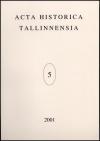KONTRREVOLUTSIOONI VASTU VÕITLEMISE KOMISJONID ENAMLASTE TERRORIPOLIITIKA TÄIDEVIIJATENA EESTIS AASTAIL 1918–1919
ON THE ROLE OF THE COMMISSIONS FOR COMBATING COUNTER-REVOLUTION IN FULFILLING THE BOLSHEVIK TERROR POLICY IN ESTONIA, 1918–1919
Author(s): Taavi MinnikSubject(s): History
Published by: Teaduste Akadeemia Kirjastus
Keywords: Estonia; Estonian History; ROLE OF THE COMMISSIONS FOR COMBATING COUNTER-REVOLUTION ; BOLSHEVIK TERROR POLICY ; ESTONIA ;1918–1919
Summary/Abstract: The extermination of the enemies of the Bolshevik regime was legitimized by the decree ‘On Red Terror’ signed by Lenin on 5 September 1918. The author believes that the mechanism of red terror in Estonia was adopted from Russia. The primary task of Estonia’s Bolshevik government or the Council of the Workers’ Commune of Estonia at the end of 1918 and the beginning of 1919 was the reinforcement of the regime in the occupied part of Estonia. The Bolshevik political police cadres were predominantly formed from Estonians, who had to evacuate to Russia in February 1918, while a large proportion of the commissars and investigators had been working in the Cheka before the Estonian War of Independence. According to the Cheka model, commissions for combating counter-revolution (hereafter all such commissions will be called CCCs) or Bolshevik political police departments, subordinated to Johannes Käspert, head of the Commune administration of internal affairs, were set up in major towns and counties seized in Estonia by the Red Army. The first CCC was formed in Narva on 5 December 1918. A total of four such regional commissions operated in the Bolshevik-controlled territory between December 1918 and January 1919: in the cities of Narva and Tartu and in the Võru and Viru counties. The last CCC, which operated in the rear of the Red Army to the south of Lake Pskov, ended its activities in the middle of May 1919. The Estonian Bolshevik government, which had evacuated to Soviet Russia in January, was disbanded on 5 June. The counteroffensive of the Estonian army, which began on 8 January 1919, prevented the Viljandi and Pärnu county CCCs from starting their activities. A total of 2500 people were arrested by the CCCs in the Bolshevik-controlled territory between December 1918 and January 1919; three quarters of them on political charges (frequently merely as ‘suspects’). Conditions in the Bolshevik prisons were particularly inhuman. The inmates were kept in crowded cells, literally in their excrement, suffering constant hunger as provisioning largely depended on their relatives, who had to deliver food packages to the prison. Humiliation and daily physical abuse by the guards were a regular occurrence in the prisons guarded by Estonian Red Guards from Russia. The Bolsheviks executed about 700 persons between December 1918 and April 1919.
Journal: Acta Historica Tallinnensia
- Issue Year: 2015
- Issue No: 21
- Page Range: 051-068
- Page Count: 18

